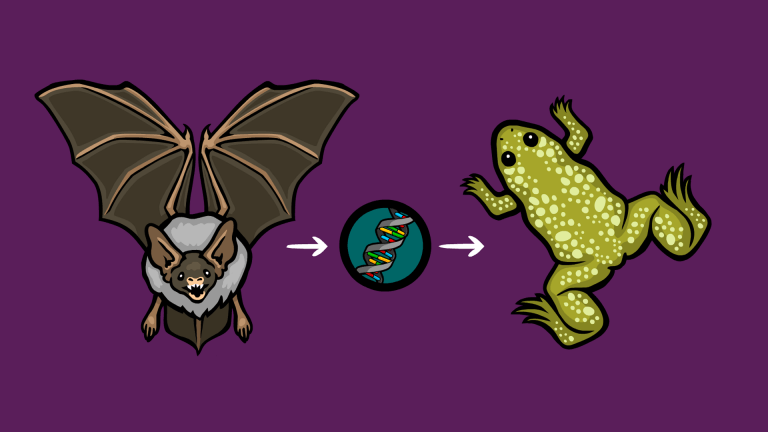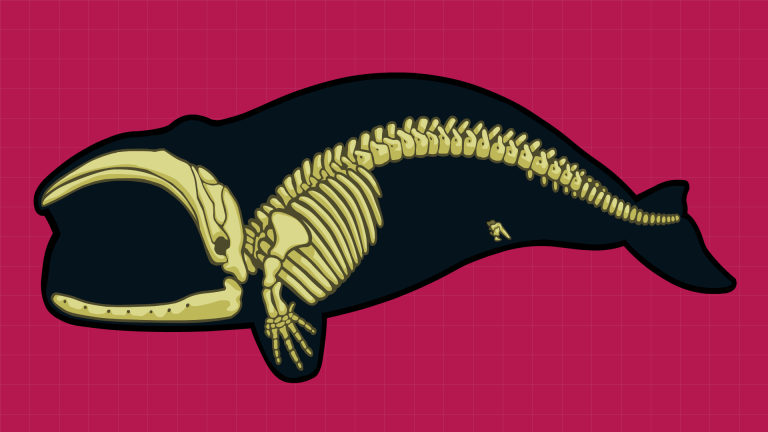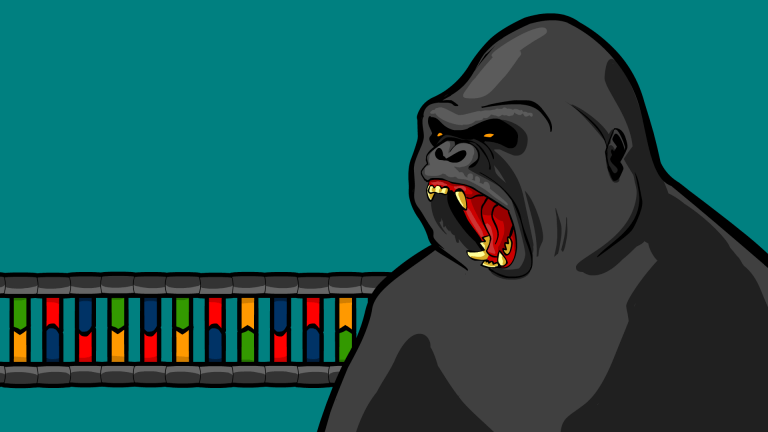Overview
Here we explore the amazing discovery of Endogenous Retroviruses (ERVs) in our own DNA. An Endogenous Retrovirus is a genetic remnant of antient virus infection suffered by an ancestor. It turns out that many of our Endogenous Retroviruses are shared by chimpanzees. This is because we share a common ancestor with them.
Explore Further
Scientific papers shown in the animation by topic:
Placental Endogenous Retrovirus research
- The placenta goes viral: Retroviruses control gene expression in pregnancy
- Review: human endogenous retroviruses and the placenta
- Retroviral envelope gene captures and syncytin exaptation for placentation in marsupials
Revival of Extinct Endogenous Retrovirus in Human DNA
Chimpanzee & human DNA comparisons
- The Origin of Man: A Chromosomal Pictorial Legacy
- Initial sequence of the chimpanzee genome and comparison with the human genome
Studies on how likely it is for an Endogenous Retrovirus to insert itself in same location of different hosts
- HIV integration site selection: Analysis by massively parallel pyrosequencing reveals association with epigenetic modifications
- Distribution of targets for avian retrovirus DNA integration in vivo
- Retroviral DNA Integration: ASLV, HIV, and MLV Show Distinct Target Site Preferences
Human Endogenous Retrovirus – W: Exact insertion locations in humans and other apes
Notes on the math used in this animation:
Estimation of possible Endogenous Retrovirus insertion sites in the human Genome
Transcript
You’ve probably heard that the great apes like chimpanzees are humankind’s closest living relatives. Even before evolution was discovered, scientists studying comparative anatomy already grouped humans into the ape family alongside chimpanzees.
In those pre-evolution years, however, the word “family” was often used figuratively. Many scientists held a “fixed species” view. They though humans and chimpanzees had been similar yet different since the dawn of time. This changed by the end of the 1800s. Along with the discovery of the process of evolution, the study of fossils convinced the majority of scientists that humans and chimps do share a common ancestor. We really are family! Today, hundreds of transitional fossils have been found which blur the line between humans and chimpanzees.
That said, some people feel that the study of fossils is too subjective Is there an independent line of evidence we can use to double check what we think we know from the study of fossils?
Dr. Francis Collins, the man who directed the human genome project, rightfully pointed out that the study of DNA gives us an entirely independent, quantifiable way to test out ideas about evolution. Instead of simply taking his word for it, here we will examine the evidence for ourselves.
It’s widely known that DNA is great at revealing family relationships. In the court of law, DNA is the gold standard for determining who the father is. DNA evidence is now widely use in the study of genealogy to figure out more distant relationships. There are many independent ways that DNA evidence can be used to reveal family relationships, even between species! Here, we’ll zoom in on just one line of evidence: Endogenous Retrovirus DNA shared across species. In this case, between humans and chimpanzees. To understand why Retrovirus DNA is such a big deal, let’s first look at what Retroviruses are.
A retrovirus is a special type of virus that reproduces by inserting its genes directly into a cells DNA. The virus genes become a permanent, seamless part of the host-cell’s genome. The cell then treats the virus DNA as if it were its own. It reads the virus genes, using them to make new viruses, and when the cell copies its own DNA before reproducing, it also copies the virus DNA and passes it on as well.
In mammals, modern retroviruses usually infect white blood cells. If, however, a retrovirus happens to infect a sperm cell or egg cell and if that sperm or egg cell happens to participate in fertilization, the resulting child will have a copy of the virus DNA in ever single one of her cells! She’ll even pass it on to her kids if she has children.
Now, you might think this is a guaranteed death sentence for the child, but the immune system can sometimes handle the problem. Normal copying errors in virus DNA will sometimes shut the viruses down.
In these cases, the retrovirus insertion can be thought of as a single giant mutation for the host. As is the case for all mutations, a retrovirus insertion might have a negative effect on the individual that contains it. It might end up being neutral, or, with a bit of luck, it could wind up being beneficial. Virus genes also act as extra genetic material that evolution will be able to “play with” as time goes on. Future mutations can give virus genes new functions, some of which might happen to be useful. Recent studies have found that in at least once case, it seems that an ancient mammal was infected with a virus that ended up helping during reproduction. Many of that mammals descendants, humans included, eventually became fully dependent on the virus. We can no longer reproduce without it. We are part virus!
When a retrovirus becomes a permeant part of a species DNA, scientists call it an endogenous retrovirus. “Endogenous” because it is inside us from birth. It turns out that the human genome contains thousands of endogenous retrovirus segments – long stretched of DNA with sequences matching those of retroviruses. Luckily for us, none of them can still make full-fledged retroviruses. They’ve simply mutated too much to still perform their original “virusy” functions.
Okay, so, If all this is news to you it’s probably a lot to take in so lets recap super quick before we look at how ERVs act as evidence of evolution.
An endogenous retrovirus is a stretch of DNA found in your DNA that got there when one of your ancestors was infected by a retrovirus. On rare occasions virus genes find their way into sperm or egg cells where they can go on to become a permanent part of a species genome.
Your endogenous retroviruses (ERVs) act as historical records of past infections suffered by our ancestors.
Now at this point you might be asking, “How do we know for sure that genes with similar sequences to virus genes actually came from viruses? Has this been experimentally demonstrated?”
In several different cases: Yes!
Scientists recently took human cells incubated in petri-dishes and slightly mutated the DNA of one of endogenous retroviruses to see if it would start producing viruses again. Sure enough it worked! An extinct virus was revived from a DNA sequence found in our very own human genome! Endogenous retroviruses really are the remaining scars of ancient virus infections.
So, how does this all act as evidence that humans, chimps, and other primates really evolved from a common ancestor?
Well, in 2003, the first draft of the chimp genome was published. Overall, human DNA and chimp DNA sequences are incredibly similar but unless we dive deeper, this fact alone can’t tell us for sure if evolution is a better explanation than the “fixed species” idea. We already know that humans and chimps have similar traits. If DNA codes for traits, we should expect our DNA to be similar as well, right? In many cases this is a reasonable point… but not in the case of endogenous retroviruses!
Remember, your endogenous retroviruses show us the unique history of specific virus infections suffered by your ancestors. They’re like scars in our DNA that and individual acquires during its lifetime and can pass on to his or her descendants but only his or her descendants.
Here we’re looking at maps of human and chimp chromosomes side by side. Chromosomes are the structures in our cells that contain our DNA.
If humans and chimps share a common ancestor, and if at least some of the infections we find in our genome occurred before the chimp/human split, we should find the same virus genes in the exact same locations in both human and chimp genomes.
In contrast, If humans and chimps are not related, they should not share the same history of virus infections.
Now, it is of course possible that, throughout history, both species were infected by some of the same viruses (humans and chimps sometimes get each other sick today) but if chimps and humans are not related, those virus genes will not be found in identical locations of both chimp and human DNA. This is because when a retrovirus infects a host, there are many different spots in the host’s genome where it might end up inserting itself.
Extensive lab experiments with retroviruses have found that there are far more than 10 million possible insertion spots in the human genome. In other words, the chance of a human and a chimp getting infected in the exact same spot by the same specific type of virus is far less than 1 in 10 million.
“So you’re saying there’s a chance?”
Well… it’s ridiculously unlikely and it gets worse fast. If two individuals are both infected with just 12 of the same viruses, the chance that each of those 12 inserted themselves into the same DNA locations of both hosts is less than 1 in the number of all the atoms estimated to exist in the observable universe!
To get a rough idea of how many insertions are shared between humans and chimps, researchers scanned both of our genomes looking for a type of retrovirus they knew was common in humans. They found 211 insertions in the human genome, 208 in chimpanzees. To figure out if any of these insertions are in the same locations in both humans and chimps, they compared the unique flanking DNA sequences on either side of each insertion. If you think of the virus as a scar, the flanking sequences are the healthy bits of tissue around the scar that tell you where that scar is located.
They found that we share not just 1, not just 12, but 205 insertions. 205 out of 214 for this particular virus group!
This makes perfect sense if evolution is true. The 205 shared viruses were inserted sometime before the chimp/human split. The 6 insertions unique to humans and the 3 unique to chimps either represent insertions that happened after the split, or they represent deletion mutations that removed a few viruses in just one lineage after the chimp/human split.
In contrast, if we want to believe the fixed species view, we are forced to conclude that these viruses are simply shared by coincidence.
When we do the math, even making sure to account for the 9 viruses not shared by the two species, the chance of this happening by coincidence is less than 1 in… this crazy number here!
This evidence should be enough for even the most reluctant yet, rational person to carefully set aside the fixed species view.
Endogenous retrovirus DNA alone is more than enough to independently confirm what we already knew from the study of fossils. That said, what we’ve seen here is just the tip of the iceberg. There are many other lines of DNA evidence available. Together they demonstrate, beyond all reasonable doubt, that humans and chimpanzees did evolve from a common ancestor. We are family.




